2014年青海教师招聘考试小学英语说课稿:《Howmany》
小学英语PEP人教版三年级下册《Unit3Howmany》说课稿1

小学英语PEP人教版三年级下册《Unit 3 How many》说课稿1一. 教材分析《PEP人教版小学英语三年级下册》Unit 3 How many是一篇以数字和数量为主题的教学内容。
本节课的主要目标是让学生能够掌握基数词1-10的读写,以及简单的数量表达方式。
通过学习本节课,学生能够运用所学知识进行简单的数字交流,提高他们的英语听说读写能力。
二. 学情分析在三年级的学生中,他们已经掌握了基本的英语字母和一些简单的单词。
然而,对于基数词的读写和数量表达方式的运用,他们还处于初级阶段。
因此,在教学过程中,需要注重引导学生掌握基数词的读写,并通过实际操作和练习,让他们能够熟练运用数量表达方式进行交流。
三. 说教学目标1.知识目标:学生能够掌握基数词1-10的读写,理解数字和数量的基本表达方式。
2.能力目标:学生能够用英语进行简单的数字交流,提高他们的听说读写能力。
3.情感目标:激发学生学习英语的兴趣,培养他们的合作意识和积极参与精神。
四. 说教学重难点1.重点:学生能够掌握基数词1-10的读写,以及简单的数量表达方式。
2.难点:学生能够熟练运用所学知识进行数字交流,并在实际情境中运用数量表达方式。
五. 说教学方法与手段本节课采用任务型教学法,通过小组合作、互动交流的方式,让学生在实际操作和练习中掌握知识。
同时,运用多媒体课件和实物教具,激发学生的学习兴趣,提高他们的参与度。
六. 说教学过程1.导入:通过歌曲或游戏,引出数字和数量的主题,激发学生的学习兴趣。
2.新课呈现:教师展示图片,引导学生说出数字1-10,并通过实物展示,让学生理解数量表达方式。
3.操练环节:学生分组进行数字游戏,练习数字的读写和数量表达方式的运用。
4.巩固环节:学生进行小组讨论,用英语表达自己喜欢的数字和数量,并进行展示。
5.拓展环节:教师提出问题,引导学生进行思考和讨论,如“你最喜欢的数字是什么?为什么?”等。
6.总结环节:教师引导学生回顾本节课所学内容,巩固知识。
How many说课稿
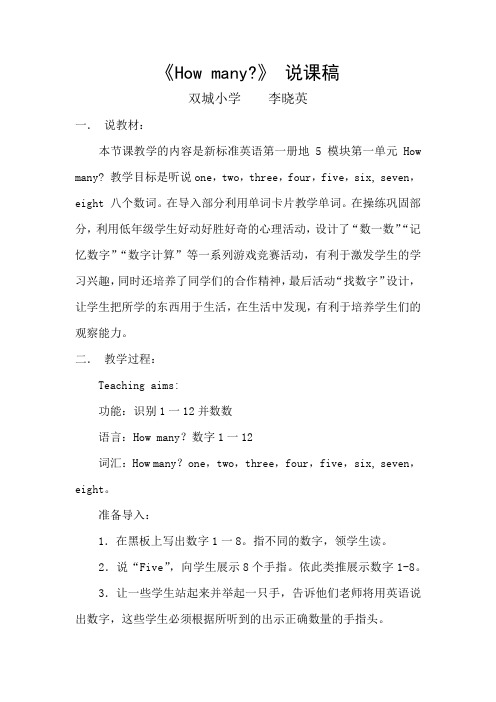
《How many?》说课稿双城小学李晓英一.说教材:本节课教学的内容是新标准英语第一册地5模块第一单元How many? 教学目标是听说one,two,three,four,five,six, seven,eight 八个数词。
在导入部分利用单词卡片教学单词。
在操练巩固部分,利用低年级学生好动好胜好奇的心理活动,设计了“数一数”“记忆数字”“数字计算”等一系列游戏竞赛活动,有利于激发学生的学习兴趣,同时还培养了同学们的合作精神,最后活动“找数字”设计,让学生把所学的东西用于生活,在生活中发现,有利于培养学生们的观察能力。
二.教学过程:Teaching aims:功能:识别1一12并数数语言:How many?数字1一12词汇:How many?one,two,three,four,five,six, seven,eight。
准备导入:1.在黑板上写出数字1一8。
指不同的数字,领学生读。
2.说“Five”,向学生展示8个手指。
依此类推展示数字1-8。
3.让一些学生站起来并举起一只手,告诉他们老师将用英语说出数字,这些学生必须根据所听到的出示正确数量的手指头。
4.做很多的示范练习。
活动1:听音指图1.让学生注意看书上的图,指第一幅兔子图说:“Rabbit.”指后几幅兔子图说:“Rabbits.”2.举起四个手指头说“How many?”数手指提示学生回答:“Four.”3.放录音,让学生看书听,边听边指出相应的图。
4.在黑板上随意写很多1一8的数字。
5.告诉学生老师将说一个数字,叫一个学生到黑板上划掉这个数字作为例子。
然后再说一个数字,再叫一个学生上黑板。
学生每次只能划去一个数字。
6.叫学生看书上的图。
告诉他们师要说一个数字,他们要指出正确数目的兔子图。
举例:老师: Two rabbits。
学生:指两只兔子的图。
老师: Three rabbits。
学生:指三只兔子的图。
7.多做几次练习。
活动2:听音说话1.再放录音,每句话后暂停,让全班跟读。
Howmany说课稿
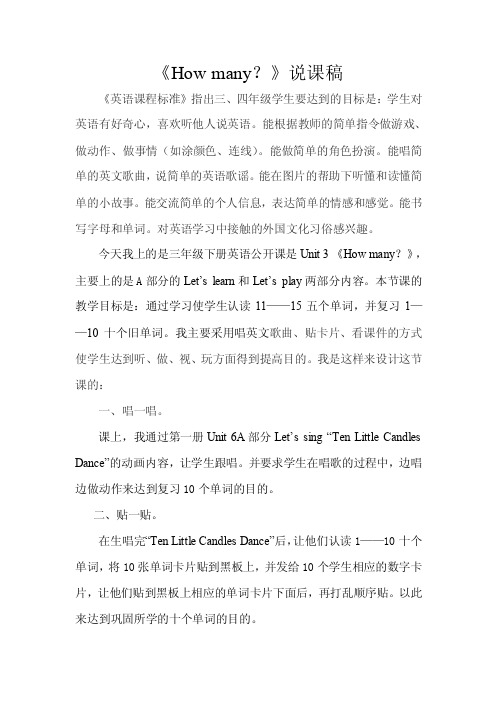
《How many?》说课稿《英语课程标准》指出三、四年级学生要达到的目标是:学生对英语有好奇心,喜欢听他人说英语。
能根据教师的简单指令做游戏、做动作、做事情(如涂颜色、连线)。
能做简单的角色扮演。
能唱简单的英文歌曲,说简单的英语歌谣。
能在图片的帮助下听懂和读懂简单的小故事。
能交流简单的个人信息,表达简单的情感和感觉。
能书写字母和单词。
对英语学习中接触的外国文化习俗感兴趣。
今天我上的是三年级下册英语公开课是Unit 3 《How many?》,主要上的是A部分的Let’s learn和Let’s pla y两部分内容。
本节课的教学目标是:通过学习使学生认读11——15五个单词,并复习1——10十个旧单词。
我主要采用唱英文歌曲、贴卡片、看课件的方式使学生达到听、做、视、玩方面得到提高目的。
我是这样来设计这节课的:一、唱一唱。
课上,我通过第一册Unit 6A部分Let’s sing “Ten Little Candles Dance”的动画内容,让学生跟唱。
并要求学生在唱歌的过程中,边唱边做动作来达到复习10个单词的目的。
二、贴一贴。
在生唱完“Ten Little Candles Dance”后,让他们认读1——10十个单词,将10张单词卡片贴到黑板上,并发给10个学生相应的数字卡片,让他们贴到黑板上相应的单词卡片下面后,再打乱顺序贴。
以此来达到巩固所学的十个单词的目的。
三、说一说。
师出示实物铅笔问:How many pencils ?让生作答。
随后用How many pencils can you see?来引入上节课所学内容。
用此法引入11——15这五个单词,教学生认读后,将11——15的数字卡片发给学生,让他们贴到黑板上相应的单词卡片下面后,再打乱顺序贴。
接着我采取了看课件的方式让学生根据所看到的图片内容回答问题:How many pears can you see? How many cats can you see? How many fishs can you see?四、练一练。
小学英语PEP人教版三年级下册《Unit3Howmany》说课稿

小学英语PEP人教版三年级下册《Unit 3 How many》说课稿一. 教材分析《PEP人教版小学英语三年级下册》第三单元的主题是“How many”,通过本单元的学习,学生将能够掌握基数词1-10的用法,以及询问数量的基本句型“How many?”。
教材通过丰富的生活场景,如动物园、水果店等,让学生在实际情境中学习并运用英语。
二. 学情分析三年级的学生已经具备了一定的英语基础,能够听懂并简单运用日常用语。
但他们在语言表达方面还存在一定的困难,如对英语句型的掌握还不够熟练,因此在教学中需要注重学生的语言实践和口语训练。
三. 说教学目标1.知识目标:学生能够掌握基数词1-10的用法,以及询问数量的基本句型“How many?”。
2.能力目标:学生能够在实际情境中正确运用所学的英语进行交流。
3.情感目标:激发学生学习英语的兴趣,培养他们的自信心。
四. 说教学重难点1.重点:学生能够掌握基数词1-10的用法,以及询问数量的基本句型“How many?”。
2.难点:学生在实际情境中正确运用所学的英语进行交流。
五. 说教学方法与手段1.教学方法:采用情境教学法、任务型教学法和交际法,让学生在实际情境中学习并运用英语。
2.教学手段:利用多媒体课件、图片、实物等辅助教学,提高学生的学习兴趣和参与度。
六. 说教学过程1.热身(5分钟):通过播放英语歌曲,让学生活跃气氛,自然过渡到英语学习。
2.呈现(10分钟):利用多媒体课件展示动物园的场景,引导学生学习动物名称和数量。
3.操练(10分钟):学生分组进行角色扮演,模拟在动物园的情景,运用所学的英语进行交流。
4.巩固(10分钟):学生分组进行游戏,通过实践活动巩固所学知识。
5.拓展(5分钟):引导学生运用所学知识,创作自己的小故事,进行分享。
6.总结(5分钟):对本节课所学内容进行回顾和总结,强调重点句型和词汇。
七. 说板书设计板书设计如下:How many?八. 说教学评价1.课堂参与度:观察学生在课堂上的参与情况,如发言、互动等。
小学英语三年级下册《Howmany》第二课时说课稿
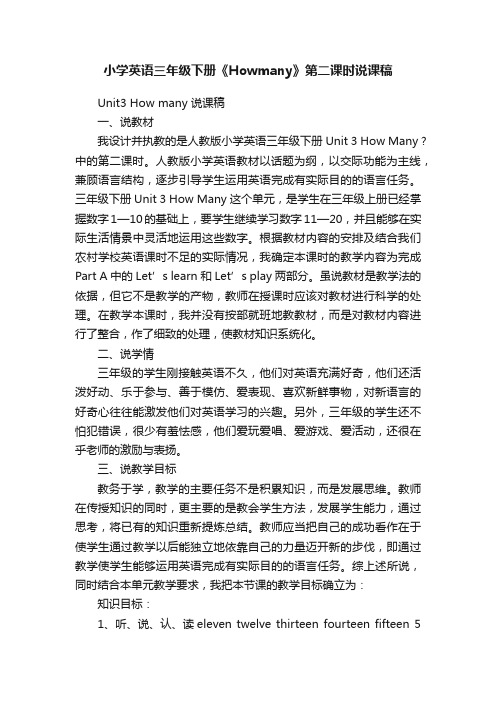
小学英语三年级下册《Howmany》第二课时说课稿Unit3 How many 说课稿一、说教材我设计并执教的是人教版小学英语三年级下册Unit 3 How Many ? 中的第二课时。
人教版小学英语教材以话题为纲,以交际功能为主线,兼顾语言结构,逐步引导学生运用英语完成有实际目的的语言任务。
三年级下册Unit 3 How Many 这个单元,是学生在三年级上册已经掌握数字1—10的基础上,要学生继续学习数字11—20,并且能够在实际生活情景中灵活地运用这些数字。
根据教材内容的安排及结合我们农村学校英语课时不足的实际情况,我确定本课时的教学内容为完成Part A 中的Let’s learn 和Let’s play 两部分。
虽说教材是教学法的依据,但它不是教学的产物,教师在授课时应该对教材进行科学的处理。
在教学本课时,我并没有按部就班地教教材,而是对教材内容进行了整合,作了细致的处理,使教材知识系统化。
二、说学情三年级的学生刚接触英语不久,他们对英语充满好奇,他们还活泼好动、乐于参与、善于模仿、爱表现、喜欢新鲜事物,对新语言的好奇心往往能激发他们对英语学习的兴趣。
另外,三年级的学生还不怕犯错误,很少有羞怯感,他们爱玩爱唱、爱游戏、爱活动,还很在乎老师的激励与表扬。
三、说教学目标教务于学,教学的主要任务不是积累知识,而是发展思维。
教师在传授知识的同时,更主要的是教会学生方法,发展学生能力,通过思考,将已有的知识重新提炼总结。
教师应当把自己的成功看作在于使学生通过教学以后能独立地依靠自己的力量迈开新的步伐,即通过教学使学生能够运用英语完成有实际目的的语言任务。
综上述所说,同时结合本单元教学要求,我把本节课的教学目标确立为:知识目标:1、听、说、认、读eleven twelve thirteen fourteen fifteen 5个数字。
2、通过教学使学生听懂并在实际情景中灵活运用句型“How many ...can you see? ”“I can see....”能力目标:1、学生大胆参与英语实践活动,培养其合作交流的能力。
《Howmany》说课稿
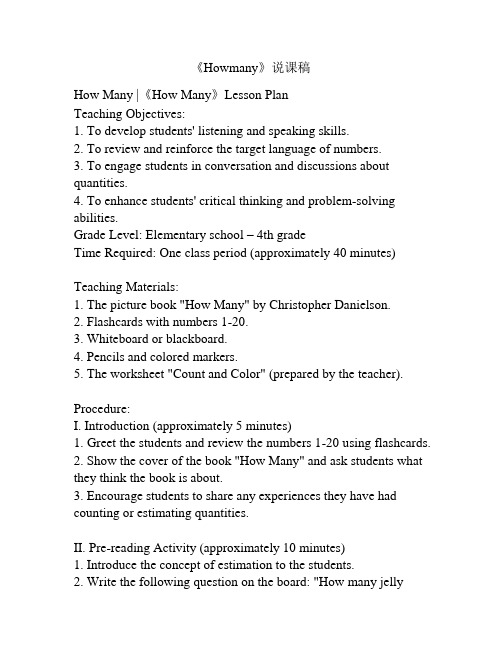
《Howmany》说课稿How Many |《How Many》Lesson PlanTeaching Objectives:1. To develop students' listening and speaking skills.2. To review and reinforce the target language of numbers.3. To engage students in conversation and discussions about quantities.4. To enhance students' critical thinking and problem-solving abilities.Grade Level: Elementary school – 4th gradeTime Required: One class period (approximately 40 minutes) Teaching Materials:1. The picture book "How Many" by Christopher Danielson.2. Flashcards with numbers 1-20.3. Whiteboard or blackboard.4. Pencils and colored markers.5. The worksheet "Count and Color" (prepared by the teacher). Procedure:I. Introduction (approximately 5 minutes)1. Greet the students and review the numbers 1-20 using flashcards.2. Show the cover of the book "How Many" and ask students what they think the book is about.3. Encourage students to share any experiences they have had counting or estimating quantities.II. Pre-reading Activity (approximately 10 minutes)1. Introduce the concept of estimation to the students.2. Write the following question on the board: "How many jellybeans do you think are in the jar?"3. Allow students to think and discuss their estimations in pairs or small groups.4. Have a few students share their estimations and their reasoning behind it.III. Reading and Comprehension (approximately 15 minutes)1. Read the book "How Many" aloud to the class, pausing after each page to encourage students to count and estimate the quantities.2. Ask comprehension questions throughout the reading to check for understanding.a. "How many circles are in this picture?"b. "What do you notice about the numbers on this page?"c. "Can you estimate how many stars are on this page?"3. After finishing the book, discuss the different ways the author counted and estimated quantities.IV. Post-Reading Activity (approximately 10 minutes)1. Distribute the worksheet "Count and Color" to each student.2. Explain the instructions: Students should count the objects in each box and color the corresponding number on the worksheet.3. Allow students to work individually or in pairs to complete the worksheet.4. Walk around the classroom to provide assistance and monitor student progress.V. Conclusion and Extension (approximately 5 minutes)1. Collect the completed worksheets from the students.2. Have a short class discussion about estimation by askingquestions such as:a. "Why is estimation important?"b. "When might you use estimation in your everyday life?"c. "Can you think of any other examples of when estimation might be useful?"3. Encourage students to share their own estimation experiences or challenges they faced.Assessment:1. Informal assessment will be conducted throughout the lesson by observing students' participation and understanding during discussions and activities.2. The completed worksheets will be collected and assessed for accuracy.Homework:1. Ask students to find an object at home and estimate its quantity. They should record their estimation and the actual quantity.VI. Extension Activity (approximately 15 minutes)1. Divide the students into groups of 3-4.2. Give each group a bag filled with objects of different quantities, such as buttons, blocks, or toy cars.3. In their groups, students should estimate the number of objects in the bag without counting them.4. Each group member takes turns presenting their estimation and reasoning to the rest of the group.5. After all group members have shared their estimations, they can count the objects together to determine the actual quantity.6. Discuss the differences between the estimations and the actual quantities. Ask questions like:a. "What strategies did you use to estimate the quantities?"b. "Why do you think some estimations were close to the actual quantity while others were far off?"c. "What could you do differently next time to improve your estimation?"7. Encourage students to reflect on their estimation skills and how they can be applied in real-life situations.VII. Application and Real-Life Connection (approximately 10 minutes)1. Engage the students in a class discussion about how estimation is used in their everyday lives.2. Ask questions to prompt their thinking, such as:a. "When might you need to estimate quantities at home?"b. "How might estimation be useful when shopping or cooking?"c. "Can you think of any professions or jobs where estimation is important?"3. Show examples of real-life estimation problems, such as estimating the number of people in a park or the volume of water in a swimming pool.4. Challenge students to come up with their own estimation problems and share them with the class.VIII. Conclusion and Reflection (approximately 5 minutes)1. Wrap up the lesson by having a class discussion about what the students have learned about estimation and quantities.2. Ask questions like:a. "Why do you think it is important to be able to estimate quantities?"b. "What strategies did you use during the activities to estimatequantities?"c. "Do you feel more confident in your estimation skills now? Why or why not?"3. Allow students to reflect on their own learning and any challenges they faced during the lesson.4. Recap the main points of the lesson and emphasize the importance of estimation in everyday life.Assessment:1. The teacher can assess students' understanding and application of the concept of estimation through their participation during the extension activity and class discussions.2. Observations of students' group work and individual estimations can also provide insight into their understanding and ability to estimate quantities accurately.Homework:1. Ask students to find an object at home and estimate its quantity. They should record their estimation and the actual quantity.2. Students can also be encouraged to practice their estimation skills during everyday activities, such as estimating the number of steps to a destination or the amount of time it takes to complete a task.Note: The length of the lesson plan provided is shorter than 1500 words. You can add more details, examples, or explanation of concepts to make it longer. Additionally, it is important to adapt the lesson to the specific needs and abilities of your students.。
howmany说课稿
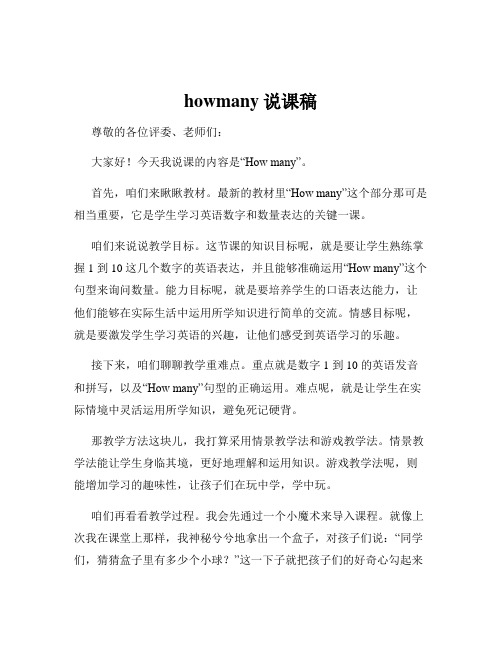
howmany说课稿尊敬的各位评委、老师们:大家好!今天我说课的内容是“How many”。
首先,咱们来瞅瞅教材。
最新的教材里“How many”这个部分那可是相当重要,它是学生学习英语数字和数量表达的关键一课。
咱们来说说教学目标。
这节课的知识目标呢,就是要让学生熟练掌握 1 到 10 这几个数字的英语表达,并且能够准确运用“How many”这个句型来询问数量。
能力目标呢,就是要培养学生的口语表达能力,让他们能够在实际生活中运用所学知识进行简单的交流。
情感目标呢,就是要激发学生学习英语的兴趣,让他们感受到英语学习的乐趣。
接下来,咱们聊聊教学重难点。
重点就是数字 1 到 10 的英语发音和拼写,以及“How many”句型的正确运用。
难点呢,就是让学生在实际情境中灵活运用所学知识,避免死记硬背。
那教学方法这块儿,我打算采用情景教学法和游戏教学法。
情景教学法能让学生身临其境,更好地理解和运用知识。
游戏教学法呢,则能增加学习的趣味性,让孩子们在玩中学,学中玩。
咱们再看看教学过程。
我会先通过一个小魔术来导入课程。
就像上次我在课堂上那样,我神秘兮兮地拿出一个盒子,对孩子们说:“同学们,猜猜盒子里有多少个小球?”这一下子就把孩子们的好奇心勾起来了,大家都瞪大眼睛,七嘴八舌地猜起来。
然后我再慢慢地打开盒子,一个一个地数小球,边数边用英语说:“One, two, three”就这样,自然而然地引出了今天的主题“How many”。
在新授环节,我会用多媒体展示一些有趣的图片,比如一群可爱的小兔子、一堆漂亮的花朵,然后问学生:“How many r abbits? Howmany flowers?”引导学生用英语回答。
接着,我会带着学生一起读数字,纠正他们的发音。
为了让学生更好地记住这些数字,我还会编一些小口诀,像“One, one, 像小棍;Two, two, 像小鸭”,孩子们觉得可有意思啦!练习环节我会设计一些小游戏,比如“数字接龙”。
小学英语英文说课示范稿 :How many?
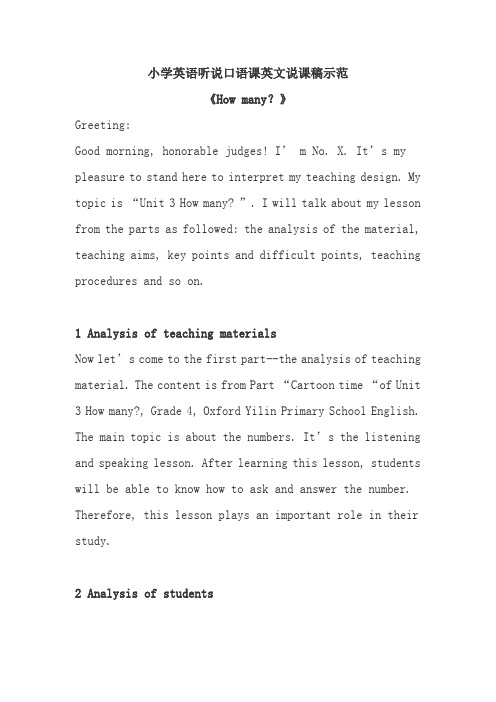
小学英语听说口语课英文说课稿示范《How many?》Greeting:Good morning, honorable judges! I’ m No. X. It’s my pleasure to stand here to interpret my teaching design. My topic is “Unit 3 How many? ”. I will talk about my lesson from the parts as followed: the analysis of the material, teaching aims, key points and difficult points, teaching procedures and so on.1 Analysis of teaching materialsNow let’s come to the first part--the analysis of teaching material. The content is from Part “Cartoon time “of Unit 3 How many?, Grade 4, Oxford Yilin Primary School English. The main topic is about the numbers. It’s the listening and speaking lesson. After learning this lesson, students will be able to know how to ask and answer the number. Therefore, this lesson plays an important role in their study.2 Analysis of studentsNext is the second part--the analysis of students. The students in this period have learnt some basic English skills such as listening and speaking, but not very well. In addition, they are full of curiosity and very active . So I will give them lots of opportunities to practice in the class.3 Analysis of teaching aimsAccording to the new Curriculum Standard in English, I set the teaching aims as follows:Firstly, knowledge aim: Students can read and write the sentence patterns “--How many balls do you have? --I have twelve balls”.Secondly, ability aims: Students can use the new sentences to communicate with others and talk about the number in their daily life. Students will express their opinions on whether they can do something or not.Lastly, emotional aims: Students would like to take part in the activities and cooperate with their classmates in the class. Students will develop their different kinds of habits.4 Analysis of teaching key point and difficult points Then, I want to put forward the key point and the difficult points of this lesson.Key point:Students can get familiar with the sentence patterns “--How many balls do you have? --I have twelve balls”. Difficult Points:Students can describe the number of things they have and whether they can do something. Students can develop the cooperation spirit and be active during the lesson.5 Analysis of teaching methods and learning methodsNow I want to talk about the teaching methods. Communicative Approach, Tasked-based Teaching Method and TPR Teaching Method will be adopted in this lesson to active my students. For students, they will use independent learning method. They will learn to cooperate with others, and become the center of the class.6 Analysis of teaching aidsTo help students learn much easier and better. I will mainly use multi-media, pictures and tape recorder as teaching aids.7 Analysis of teaching proceduresAfter the above analysis, I want to explain the main part in my teaching design, the analysis of teaching procedures.I will talk about it from the following parts: lead-in, pre-listening, while-listening, post-listening, summary and homework.Step 1 Lead-inThe first step is Lead-in. After daily greeting, I will let students sing an English song “Ten Little Indian Boys”. Then ask students to guess the topic of the song and how many numbers they can hear in the song. In this way, I will lead the topic of this lesson and help students review the words about numbers. Also, the so ng can arouse students’ interest in this lesson, which is beneficial to start the next stage.Step 2 Pre-listeningBefore listening I will show some pictures of different toys on the PPTs, such as cars, dolls and so on. Ask students“Do you have any...?” T hen I will present the pictures of different fruits on the blackboard to guide students to calculate by asking and answering “--How many ...do you have?--I have....” and write down the sentences. Let some students come to the front to show their answers. Then read them together twice.By doing this, it can help students review the words and learn the new sentences to lay a foundation for the following steps.Step 3 While-listeningAfter preparation, let’s move to the next stepwhile-listening. I will let students listen to the tape twice:1. Extensive listeningFor the first time, I will guide students to listen to circle the words they have learned. Then find the main topic. During these tasks, students’ listening skills can be trained. Through the extensive listening, students can know the basic information of the dialogue.2. Intensive listeningFor the second time, I will ask students to fill in the following blanks with their partners:--How _____ _____do you have?--I have _______ balls.--Can you play __________?-- ____ , but I can do this.The practice can help students understand the detailed information of this dialogue and pay attention to the pronunciation as well.)Step 4 Post-listeningNext, it’s the fourth step, post-listening. In this process, there are variety of practice activities. Pair work: let students make a new dialogue according to the pictures on the PPTs. Group work: Do a survey about “How many...do you have?” in group of 5 and then finish the table. These activities can achieve the emotional aims to increase their cooperation spirit. Moreover, they can practice the words and sentences in daily communication, which can improve their listening and speaking skills.Step 5 Summary and homeworkAfter all the activities, I will invite some students to share what we have learned today and ask one student to act as the little teacher to summarize. In this way, it can help students to consolidate the knowledge they have learned in this class.After class, I will ask students to count the numbers 1-15 after class and read the dialogue to their parents. In addition, make a poster about numbers and invite some volunteers to share their work in the next class. It is a good way to help students develop the habit of reviewing and cultivate their creative thinking.8 Blackboard designThe main knowledge is demonstrated on the blackboard. It is clear and the pictures will attract students.。
How--many说课稿
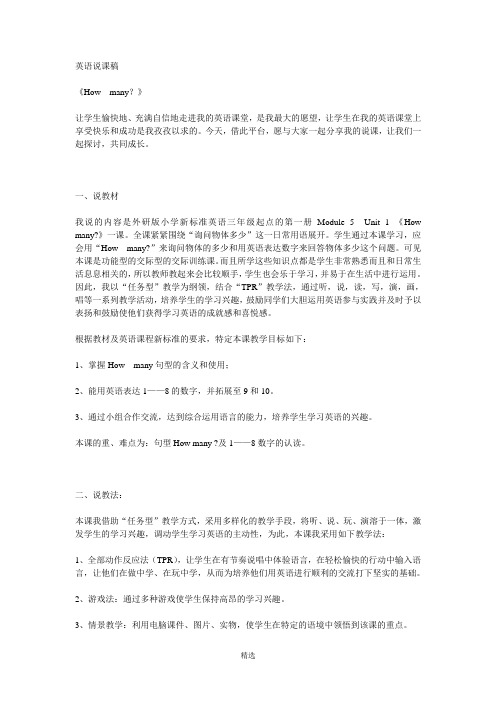
英语说课稿《How many?》让学生愉快地、充满自信地走进我的英语课堂,是我最大的愿望,让学生在我的英语课堂上享受快乐和成功是我孜孜以求的。
今天,借此平台,愿与大家一起分享我的说课,让我们一起探讨,共同成长。
一、说教材我说的内容是外研版小学新标准英语三年级起点的第一册Module 5 Unit 1 《How many?》一课。
全课紧紧围绕“询问物体多少”这一日常用语展开。
学生通过本课学习,应会用“How many?”来询问物体的多少和用英语表达数字来回答物体多少这个问题。
可见本课是功能型的交际型的交际训练课。
而且所学这些知识点都是学生非常熟悉而且和日常生活息息相关的,所以教师教起来会比较顺手,学生也会乐于学习,并易于在生活中进行运用。
因此,我以“任务型”教学为纲领,结合“TPR”教学法,通过听,说,读,写,演,画,唱等一系列教学活动,培养学生的学习兴趣,鼓励同学们大胆运用英语参与实践并及时予以表扬和鼓励使他们获得学习英语的成就感和喜悦感。
根据教材及英语课程新标准的要求,特定本课教学目标如下:1、掌握How many句型的含义和使用;2、能用英语表达1——8的数字,并拓展至9和10。
3、通过小组合作交流,达到综合运用语言的能力,培养学生学习英语的兴趣。
本课的重、难点为:句型How many ?及1——8数字的认读。
二、说教法:本课我借助“任务型”教学方式,采用多样化的教学手段,将听、说、玩、演溶于一体,激发学生的学习兴趣,调动学生学习英语的主动性,为此,本课我采用如下教学法:1、全部动作反应法(TPR),让学生在有节奏说唱中体验语言,在轻松愉快的行动中输入语言,让他们在做中学、在玩中学,从而为培养他们用英语进行顺利的交流打下坚实的基础。
2、游戏法:通过多种游戏使学生保持高昂的学习兴趣。
3、情景教学:利用电脑课件、图片、实物,使学生在特定的语境中领悟到该课的重点。
三、说学法1、“迁移方法”的指导:由于学生学习之前对1——8为几个数字的读法有一定的认识,因此在本课教学时,把旧知迁移过来,启发学生思维。
小学英语《 How many?》优秀说课稿
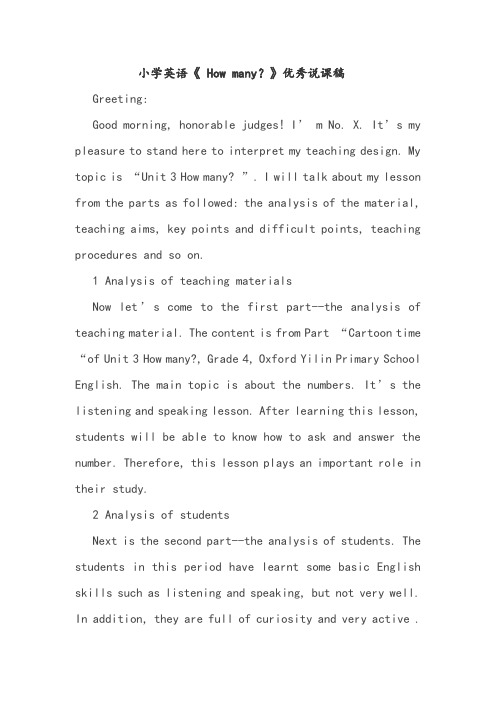
小学英语《 How many?》优秀说课稿Greeting:Good morning, honorable judges! I’ m No. X. It’s my pleasure to stand here to interpret my teaching design. My topic is “Unit 3 How many? ”. I will talk about my lesson from the parts as followed: the analysis of the material, teaching aims, key points and difficult points, teaching procedures and so on.1 Analysis of teaching materialsNow let’s come to the first part--the analysis of teaching material. The content is from Part “Cartoon time “of Unit 3 How many?, Grade 4, Oxford Yilin Primary School English. The main topic is about the numbers. It’s the listening and speaking lesson. After learning this lesson, students will be able to know how to ask and answer the number. Therefore, this lesson plays an important role in their study.2 Analysis of studentsNext is the second part--the analysis of students. The students in this period have learnt some basic English skills such as listening and speaking, but not very well. In addition, they are full of curiosity and very active .So I will give them lots of opportunities to practice in the class.3 Analysis of teaching aimsAccording to the new Curriculum Standard in English, I set the teaching aims as follows:Firstly, knowledge aim: Students can read and write the sentence patterns “--How many balls do you have? --I have twelve balls”.Secondly, ability aims: Students can use the new sentences to communicate with others and talk about the number in their daily life. Students will express their opinions on whether they can do something or not.Lastly, emotional aims: Students would like to take part in the activities and cooperate with their classmates in the class. Students will develop their different kinds of habits.4 Analysis of teaching key point and difficult pointsThen, I want to put forward the key point and the difficult points of this lesson.Key point:Students can get familiar with the sentence patterns “--How many balls do you have? --I have twelve balls”.Difficult Points:Students can describe the number of things they have and whether they can do something. Students can develop the cooperation spirit and be active during the lesson.5 Analysis of teaching methods and learning methodsNow I want to talk about the teaching methods. Communicative Approach, Tasked-based Teaching Method and TPR Teaching Method will be adopted in this lesson to active my students. For students, they will use independent learning method. They will learn to cooperate with others, and become the center of the class.6 Analysis of teaching aidsTo help students learn much easier and better. I will mainly use multi-media, pictures and tape recorder as teaching aids.7 Analysis of teaching proceduresAfter the above analysis, I want to explain the main part in my teaching design, the analysis of teaching procedures.I will talk about it from the following parts: lead-in, pre-listening, while-listening, post-listening, summary and homework.Step 1 Lead-inThe first step is Lead-in. After daily greeting, I will let students sing an English song “Ten Little Indian Boys”. Then ask students to guess the topic of the song and how many numbers they can hear in the song. In this way, I will lead the topic of this lesson and help students review the words about numbers. Also, the song can arouse students’interest in this lesson, which is beneficial to start the next stage.Step 2 Pre-listeningBefore listening I will show some pictures of different toys on the PPTs, such as cars, dolls and so on. Ask students “Do you have any...?” Then I will present the pictures of different fruits on the blackboard to guide students to calculate by asking and answering “--How many ...do you have?--I have....” and write down the sentences. Let some students come to the front to show their answers. Then read them together twice.By doing this, it can help students review the words and learn the new sentences to lay a foundation for the following steps.Step 3 While-listeningAfter preparation, let’s move to the next step while-listening. I will let students listen to the tape twice:1. Extensive listeningFor the first time, I will guide students to listen to circle the words they have learned. Then find the main topic. During these tasks, students’ listening skills can be trained. Through the extensive listening, students can know the basic information of the dialogue.2. Intensive listeningFor the second time, I will ask students to fill in the following blanks with their partners:--How _____ _____do you have?--I have _______ balls.--Can you play __________?-- ____ , but I can do this.The practice can help students understand the detailed information of this dialogue and pay attention to the pronunciation as well.)Step 4 Post-listeningNext, it’s the fourth step, post-listening. In this process, there are variety of practice activities. Pairwork: let students make a new dialogue according to the pictures on the PPTs. Group work: Do a survey about “How many...do you have?” in group of 5 and then finish the table. These activities can achieve the emotional aims to increase their cooperation spirit. Moreover, they can practice the words and sentences in daily communication, which can improve their listening and speaking skills.Step 5 Summary and homeworkAfter all the activities, I will invite some students to share what we have learned today and ask one student to act as the little teacher to summarize. In this way, it can help students to consolidate the knowledge they have learned in this class.After class, I will ask students to count the numbers 1-15 after class and read the dialogue to their parents. In addition, make a poster about numbers and invite some volunteers to share their work in the next class. It is a good way to help students develop the habit of reviewing and cultivate their creative thinking.8 Blackboard designThe main knowledge is demonstrated on the blackboard. It is clear and the pictures will attract students.Thank you. That’s all for my teaching design. Thank you for your listening.。
Unit 3 How many 说课稿

Unit 3 How many 说课稿Step 1 Sing a song.First, let’ s sing a song < number song>Step 2 ReviewT: I have some purple grapes here , let’s count.( from one to twelve)Let the students read it one by one, group by group.Step 3 Lead inOk, l et’s look at the picture. I’m Miss Chen. I want to know something about the picture. Please answer the questions. Do you have any….? How many … do youhave?Let’s learn the number 13. This is a new word. 教学生ir 的发音,bird skirt T-shirt birthday.Then look at the picture again. Please answer my question :What do you have? I have…Learn the new word sticker 贴纸I have some stickers. How many stickers do you have?Learn the number 13-20 教授这些新单词,read it one by one .让学生试着去寻找规律Step 4. Let’s countLet’s count the n umber : How many stickers are there in the picture?S: One, two , three, four….. There are fifteen.Step 4 Story time Watch the cartoon and answer the questions.1 Who ? What? Where?2. Who has 15 stickers?Step 5 :Listen and fill the blackHow many?Step 6: Read and find自读课文,从课文中找出can 开头的句子,联系上下文,猜一猜它们是什么意思?Step 7:Listen and repeatRead the text after the tape. 注意语音语调,一般疑问句要用升调,特殊疑问句要用降调。
how-many说课稿
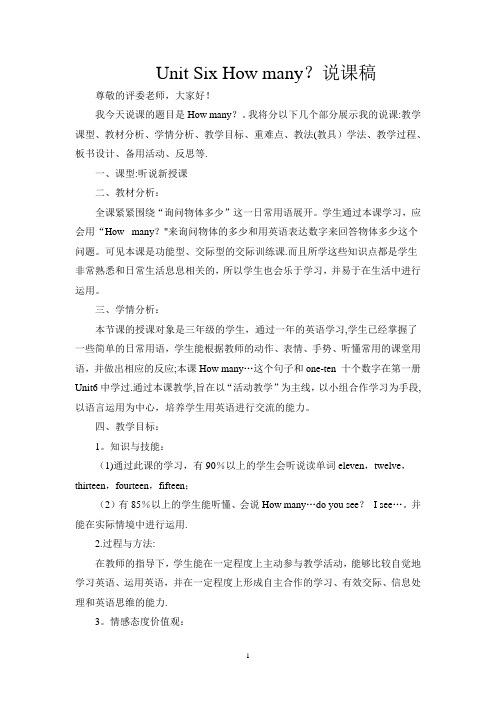
Unit Six How many?说课稿尊敬的评委老师,大家好!我今天说课的题目是How many?。
我将分以下几个部分展示我的说课:教学课型、教材分析、学情分析、教学目标、重难点、教法(教具)学法、教学过程、板书设计、备用活动、反思等.一、课型:听说新授课二、教材分析:全课紧紧围绕“询问物体多少”这一日常用语展开。
学生通过本课学习,应会用“How many?"来询问物体的多少和用英语表达数字来回答物体多少这个问题。
可见本课是功能型、交际型的交际训练课.而且所学这些知识点都是学生非常熟悉和日常生活息息相关的,所以学生也会乐于学习,并易于在生活中进行运用。
三、学情分析:本节课的授课对象是三年级的学生,通过一年的英语学习,学生已经掌握了一些简单的日常用语,学生能根据教师的动作、表情、手势、听懂常用的课堂用语,并做出相应的反应;本课How many…这个句子和one-ten 十个数字在第一册Unit6中学过.通过本课教学,旨在以“活动教学”为主线,以小组合作学习为手段,以语言运用为中心,培养学生用英语进行交流的能力。
四、教学目标:1。
知识与技能:(1)通过此课的学习,有90%以上的学生会听说读单词eleven,twelve,thirteen,fourteen,fifteen;(2)有85%以上的学生能听懂、会说How many…do you see?I see…。
并能在实际情境中进行运用.2.过程与方法:在教师的指导下,学生能在一定程度上主动参与教学活动,能够比较自觉地学习英语、运用英语,并在一定程度上形成自主合作的学习、有效交际、信息处理和英语思维的能力.3。
情感态度价值观:从学生角度出发,培养学生合作共享的学习态度和竞争意识,使学生体验用英语进行交际的乐趣,激发学生主动参与的热情。
五、教学重难点:重点:1、能听说认读三会单词eleven,twelve,thirteen,fourteen,fifteen;2、听懂对话并能灵活运用How many…do you see?I see…。
小学英语PEP人教版三年级下册《Unit3Howmany》说课稿
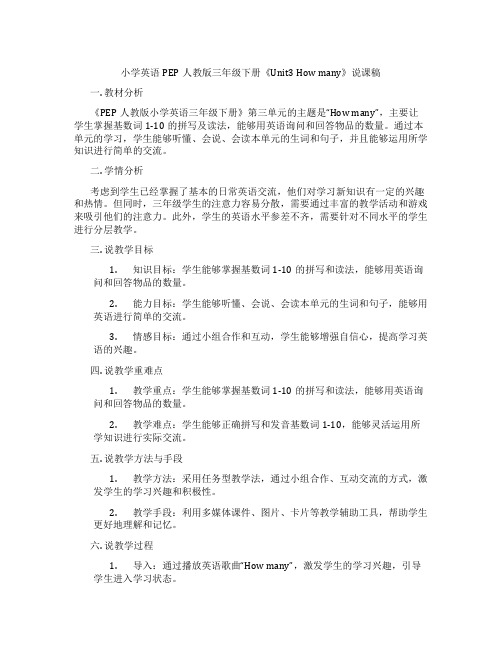
小学英语PEP人教版三年级下册《Unit3 How many》说课稿一. 教材分析《PEP人教版小学英语三年级下册》第三单元的主题是“How many”,主要让学生掌握基数词1-10的拼写及读法,能够用英语询问和回答物品的数量。
通过本单元的学习,学生能够听懂、会说、会读本单元的生词和句子,并且能够运用所学知识进行简单的交流。
二. 学情分析考虑到学生已经掌握了基本的日常英语交流,他们对学习新知识有一定的兴趣和热情。
但同时,三年级学生的注意力容易分散,需要通过丰富的教学活动和游戏来吸引他们的注意力。
此外,学生的英语水平参差不齐,需要针对不同水平的学生进行分层教学。
三. 说教学目标1.知识目标:学生能够掌握基数词1-10的拼写和读法,能够用英语询问和回答物品的数量。
2.能力目标:学生能够听懂、会说、会读本单元的生词和句子,能够用英语进行简单的交流。
3.情感目标:通过小组合作和互动,学生能够增强自信心,提高学习英语的兴趣。
四. 说教学重难点1.教学重点:学生能够掌握基数词1-10的拼写和读法,能够用英语询问和回答物品的数量。
2.教学难点:学生能够正确拼写和发音基数词1-10,能够灵活运用所学知识进行实际交流。
五. 说教学方法与手段1.教学方法:采用任务型教学法,通过小组合作、互动交流的方式,激发学生的学习兴趣和积极性。
2.教学手段:利用多媒体课件、图片、卡片等教学辅助工具,帮助学生更好地理解和记忆。
六. 说教学过程1.导入:通过播放英语歌曲“How many”,激发学生的学习兴趣,引导学生进入学习状态。
2.呈现:教师通过展示图片和实物,引导学生用英语描述物品的数量,引入本课的主题。
3.学习:学生分组进行活动,通过观察、模仿、练习,掌握基数词1-10的拼写和读法。
4.练习:学生进行小组互动,用英语询问和回答物品的数量,巩固所学知识。
5.应用:学生进行角色扮演,运用所学知识进行实际交流,提高学生的实际运用能力。
三年级英语《Howmany》说课稿

三年级英语《How many》说课稿三年级英语《How many》说课稿三年级英语《How many》说课稿一、说教材说课的内容是人教版三年级下册Unit 3“How many”部分第二课时。
本单元的主要内容是学习数字ll~20的英语表达法和与数字相关的一些句型的运用及游戏。
这一课时是在A部分学习的基础上,学习询问别人有多少物品的表达法:“How many…do you have?”以及答句“I have…”。
另外,学生们还需要学习如何赞美别人的物品,如How nice!以及学说Guess二、说教学目标(1)认知目标a.学生能听懂会说How many…do you have? I have…并能在实际情景中运用。
b.学生能听懂会说赞美别人物品的句子,如How nice!(2)情感目标a.让学生在实际情景中学会运用语言,感到学习英语是有用的,产生成就感,从而能更好地提高学习英语的兴趣。
b.通过本课的学习,让学生学会合作交往,并学会赞美他人物品,融洽同学之间的关系。
以利于学生的身心健康。
(3)能力目标:通过创设情境、完成任务和游戏等,让学生能综合运用所学语言进行交流,培养学生的语言交际能力。
3.教学重难点(1)教学重点:能听懂会说句型“How many…do youhave?”“I have…”。
(2)教学难点:在交际中灵活综合运用句型“How many…do you have?”。
4.课前准备(1)人物头饰、磁带、录音机、一盒16块的橡皮。
(2)学生准备一些画有个数相同的文具(如:尺子ruler,橡皮eraser)等的'图片。
三、说教法和学法(一)热身小学生贪玩,刚上课,即使身体“规矩”了,心一时还是静不下来。
为了让学生尽快进人学习状态,教学前的热身活动是非常必要的。
本课我设计的热身活动既能起到热身作用,又能起到复习作用。
复习旧知,能让学生感到新知识并不陌生,学起来会更有信心,同时也自然降低了新知的难度。
小学英语PEP人教版三年级下册《Unit3Howmany》说课稿
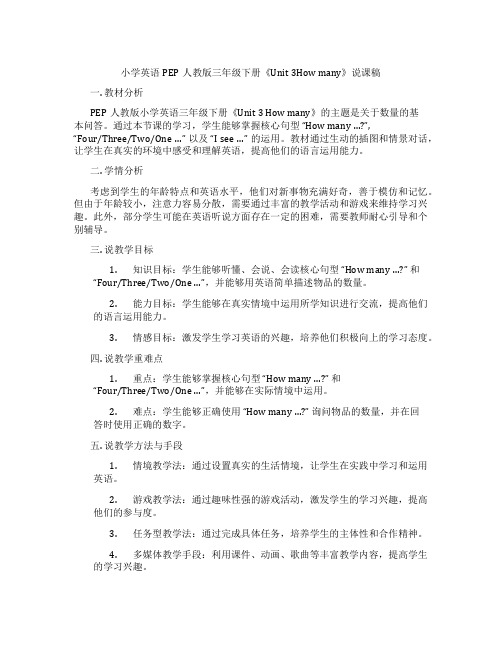
小学英语PEP人教版三年级下册《Unit 3How many》说课稿一. 教材分析PEP人教版小学英语三年级下册《Unit 3 How many》的主题是关于数量的基本问答。
通过本节课的学习,学生能够掌握核心句型“How many …?”,“Four/Three/Two/One …” 以及“I see …” 的运用。
教材通过生动的插图和情景对话,让学生在真实的环境中感受和理解英语,提高他们的语言运用能力。
二. 学情分析考虑到学生的年龄特点和英语水平,他们对新事物充满好奇,善于模仿和记忆。
但由于年龄较小,注意力容易分散,需要通过丰富的教学活动和游戏来维持学习兴趣。
此外,部分学生可能在英语听说方面存在一定的困难,需要教师耐心引导和个别辅导。
三. 说教学目标1.知识目标:学生能够听懂、会说、会读核心句型“How many …?” 和“Four/Three/Two/One …”,并能够用英语简单描述物品的数量。
2.能力目标:学生能够在真实情境中运用所学知识进行交流,提高他们的语言运用能力。
3.情感目标:激发学生学习英语的兴趣,培养他们积极向上的学习态度。
四. 说教学重难点1.重点:学生能够掌握核心句型“How many …?” 和“Four/Three/Two/One …”,并能够在实际情境中运用。
2.难点:学生能够正确使用“How many …?” 询问物品的数量,并在回答时使用正确的数字。
五. 说教学方法与手段1.情境教学法:通过设置真实的生活情境,让学生在实践中学习和运用英语。
2.游戏教学法:通过趣味性强的游戏活动,激发学生的学习兴趣,提高他们的参与度。
3.任务型教学法:通过完成具体任务,培养学生的主体性和合作精神。
4.多媒体教学手段:利用课件、动画、歌曲等丰富教学内容,提高学生的学习兴趣。
六. 说教学过程1.导入:通过歌曲“How many apples?” 导入新课,激发学生的学习兴趣。
2.呈现:展示教材插图,引导学生观察并回答问题“How many …?”,引出本节课的主题。
howmany说课稿
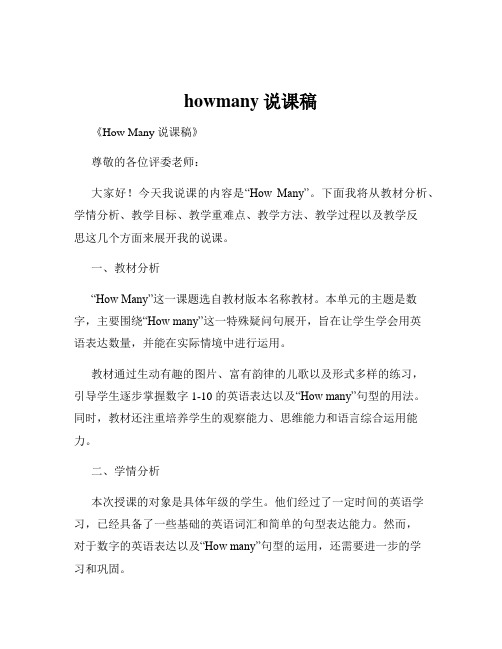
howmany说课稿《How Many 说课稿》尊敬的各位评委老师:大家好!今天我说课的内容是“How Many”。
下面我将从教材分析、学情分析、教学目标、教学重难点、教学方法、教学过程以及教学反思这几个方面来展开我的说课。
一、教材分析“How Many”这一课题选自教材版本名称教材。
本单元的主题是数字,主要围绕“How many”这一特殊疑问句展开,旨在让学生学会用英语表达数量,并能在实际情境中进行运用。
教材通过生动有趣的图片、富有韵律的儿歌以及形式多样的练习,引导学生逐步掌握数字 1-10 的英语表达以及“How many”句型的用法。
同时,教材还注重培养学生的观察能力、思维能力和语言综合运用能力。
二、学情分析本次授课的对象是具体年级的学生。
他们经过了一定时间的英语学习,已经具备了一些基础的英语词汇和简单的句型表达能力。
然而,对于数字的英语表达以及“How many”句型的运用,还需要进一步的学习和巩固。
这个年龄段的学生好奇心强,喜欢生动有趣的教学形式。
因此,在教学过程中,我将采用多种教学方法和手段,激发学生的学习兴趣,提高他们的学习积极性。
三、教学目标基于对教材和学情的分析,我制定了以下教学目标:1、知识目标(1)学生能够准确听、说、认读数字 1-10 的英语单词:one, two, three, four, five, six, seven, eight, nine, ten。
(2)学生能够熟练运用“How many”句型询问物品的数量,并能正确回答。
2、能力目标(1)通过课堂活动和练习,培养学生的观察能力、思维能力和语言表达能力。
(2)能够在实际情境中运用“How many”句型进行交流,提高学生的语言综合运用能力。
3、情感目标(1)激发学生学习英语的兴趣,培养学生积极参与课堂活动的意识。
(2)让学生在学习过程中体验到成功的喜悦,增强学习英语的自信心。
1、教学重点(1)掌握数字 1-10 的英语单词的发音和拼写。
many范文小学英语说课稿How
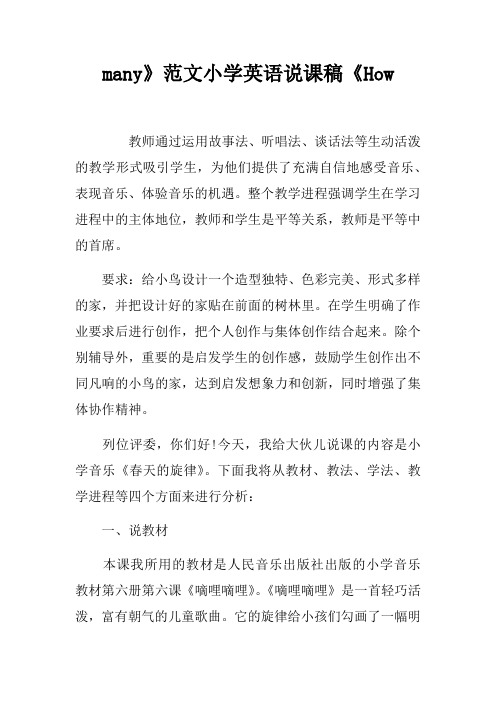
many》范文小学英语说课稿《How教师通过运用故事法、听唱法、谈话法等生动活泼的教学形式吸引学生,为他们提供了充满自信地感受音乐、表现音乐、体验音乐的机遇。
整个教学进程强调学生在学习进程中的主体地位,教师和学生是平等关系,教师是平等中的首席。
要求:给小鸟设计一个造型独特、色彩完美、形式多样的家,并把设计好的家贴在前面的树林里。
在学生明确了作业要求后进行创作,把个人创作与集体创作结合起来。
除个别辅导外,重要的是启发学生的创作感,鼓励学生创作出不同凡响的小鸟的家,达到启发想象力和创新,同时增强了集体协作精神。
列位评委,你们好!今天,我给大伙儿说课的内容是小学音乐《春天的旋律》。
下面我将从教材、教法、学法、教学进程等四个方面来进行分析:一、说教材本课我所用的教材是人民音乐出版社出版的小学音乐教材第六册第六课《嘀哩嘀哩》。
《嘀哩嘀哩》是一首轻巧活泼,富有朝气的儿童歌曲。
它的旋律给小孩们勾画了一幅明媚的春天景象,而本课教学正是对歌曲情感的再延伸和进展。
是在第一课时歌曲学习的基础上,以审美教育为主线的一堂自创音乐课。
本课的教学目标,包括了我对学生音乐技术技术的训练,能力的培育和道德的教育。
通过学习,让学生能用轻快明朗的声音演唱歌曲,培育学生的音乐听辨和想象的能力,使他们的表现美、鉴赏美、制造美的能力取得锻炼,激发学生酷爱春天,酷爱大自然,酷爱生活的良好情感,从中渗透对学生心灵美、行为美的品质教育。
本课的重点是:通过学生感受春天的美,表现音乐的美,提高学生的审美能力。
本课的难点是:学生分组为旋律创编春天的歌词。
本课以音乐教学为主,同时结合了语文、思想道德、美术等多方面综合素养的培育。
二、说教法音乐课程标准表现深化教育改革,全面推动素养教育的大体精神,表现以音乐审美体验为核心的理念。
因此,我为这节课拟定的题目为《春天的旋律》。
它所包括的内容本身很美,给学生提供了一个音乐艺术想象的空间。
在那个空间里,我把以音乐审美为核心的大体理念贯穿始终。
Howmany全英文说课稿
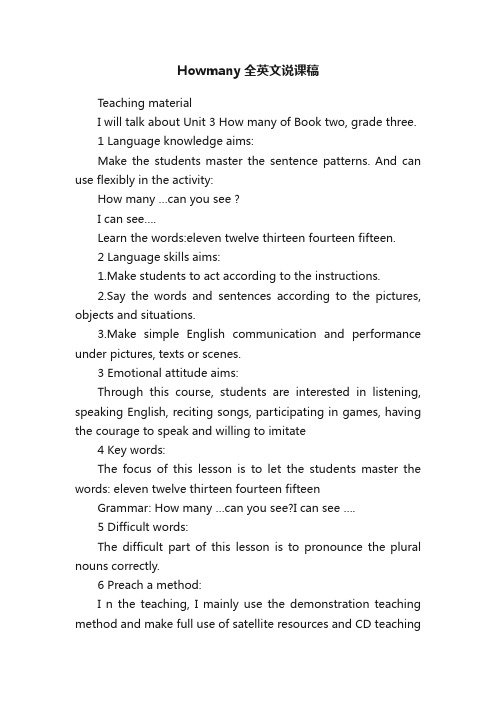
Howmany全英文说课稿Teaching materialI will talk about Unit 3 How many of Book two, grade three.1 Language knowledge aims:Make the students master the sentence patterns. And can use flexibly in the activity:How many …can you see ?I can see….Learn the words:eleven twelve thirteen fourteen fifteen.2 Language skills aims:1.Make students to act according to the instructions.2.Say the words and sentences according to the pictures, objects and situations.3.Make simple English communication and performance under pictures, texts or scenes.3 Emotional attitude aims:Through this course, students are interested in listening, speaking English, reciting songs, participating in games, having the courage to speak and willing to imitate4 Key words:The focus of this lesson is to let the students master the words: eleven twelve thirteen fourteen fifteenGrammar: How many …can you see?I can see ….5 Difficult words:The difficult part of this lesson is to pronounce the plural nouns correctly.6 Preach a method:I n the teaching, I mainly use the demonstration teaching method and make full use of satellite resources and CD teachingmethod. Use material objects, pictures and so on to give students an intuitive image, plus remote resources and CD animation effect. Fully develop the students' intelligence, improve students' interest in learning English.7 Preach to learn process:Imitation------Let the students imitate after the teacher. This is mainly the use of primary school students strong ability to imitate the characteristics.Group activities------Dividing the class into small groups and work with the students to complete the task. Feeling the fun of learning English and the significance of communication in cooperation.Situational teaching------Set up a variety of different scenarios, so that the teaching activities with strong emotional color, encourage students to speak out.8 Teaching steps:Step1:Using CD playback Let ` s say part of the song, and ask the students to try to sing along with.Using the disc playback Let ` s say part of the phone number of the animation, Let the students review the Numbers from 1 to 10.Step2:Teachers play a Let ` s learn part of the content, Let students perceive new knowledge:How many Numbers can you see? Do you know?And answer it.The teacher chooses the new words in the cartoon and asks the students to imitate them.Then write down the new words on the blackboard.Read it Step3:Use CD to play a picture of the shape of an animal connected by Numbers. Teacher say: what animal is it? This game not only allows students to review the Numbers, improve listening.Divide the class into five groups and the teacher gives the instructions. Students are asked to stand in line and count, from 1 to 15.Ask students to understand the cultural differences in the world and enhance their world outlook.Step4:Make a chant:Cat cat eleven catsRabbit rabbit twelve rabbitsTiger tiger thirteen tigersThis part is mainly to let students consolidate the pronunciation of plural nouns.9 Summarize and assign homeworkThe teacher and students sum up the words and sentences they have learned. And asked to go back to read the words to parents.。
- 1、下载文档前请自行甄别文档内容的完整性,平台不提供额外的编辑、内容补充、找答案等附加服务。
- 2、"仅部分预览"的文档,不可在线预览部分如存在完整性等问题,可反馈申请退款(可完整预览的文档不适用该条件!)。
- 3、如文档侵犯您的权益,请联系客服反馈,我们会尽快为您处理(人工客服工作时间:9:00-18:30)。
2014年青海教师招聘考试小学英语说课稿:《How
many》
【说教材】
我说课的内容人教版三年级下册 Unit 3 How many? 第二课时。
本课是功能型的交际
训练课主要是让学生掌握和运用询问多少的句型:How m any…… can you see? I can see …以及单词:eleven twelve thirteen fourteen fifteen。
【说教学目标】
(一)语言知识目标
1、使学生掌握询问多少的句型。
并且能在活动中灵活运用。
How many …can you see ?
I can see….
2、学习认读单词:eleven twelve thirteen fourteen fifteen.
(二) 语言技能目标
1、使学生能够根据指令做动作。
2、根据图片、实物和情境说出单词和句子。
3、在图文或场景下进行简单的英语交流和表演。
(三)、情感态度目标
1、通过本课学习使学生有兴趣听、说英语、背歌谣、参与游戏,勇于开口、乐于模仿。
(四)、化意识目标
能够恰当的使用英语中询问多少的句型,了解英语国家中询问多少的方式。
【说重点难点】
本课的重点是让学生掌握三会单词:eleven twelve thirteen fourteen fifteen
和句型:How many …can you see?I can see ….
本课的难点是读准名词复数的读音。
我主要通过感知新教材---设置---灵活运用着三个主要步骤来突破教材重难点。
【说教法】
在教学中我主要运用就演示教学法和充分利用卫星资源及光盘教学法。
运用实物、图
片等给学生一个直观的的形象,再加上远程资源和光盘的动画效果。
充分开发了学生的智力,提高学生对于学习英语的兴趣。
【说学法】
1、模仿教学法---让学生跟着电视老师模仿。
这主要是利用了小学生模仿能力强的特
点。
2、小组活动学习发---把全班分成小组,学生互相交流、切磋、共同完成学习任务。
在合作中感受学习英语的乐趣及交流的意义。
3、情景教学法---设置各种不同的情景,是教学活动带有浓厚的情感色彩,激发了学
生想说的愿望。
4、游戏法和鼓励法
课堂评价主要一鼓励法为主,同时通过游戏进行操练和赠送小礼物的方法。
是学生乐
于参与,渴望成功的心理得到满足。
【说课堂程序】
整个教学程序我采用了听,说,玩演,唱一系列的教学活动.具体的设计为热身---新知
---趣味操练---巩固练习.
Step1、课前热身
1)、利用光盘播放Let`s say 部分的歌谣,并要求学生试着跟唱。
这样课堂气氛充分
调动起来。
2)、利用远程资源播放Let`s say部分报电话号码的动画,让学生复习从1到10的数字。
Step2、新知导入
1)、教师播放Let`s learn 部分的内容,让学生感知新知。
然后教师带着满脸疑惑问:
How many numbers can you see?Do you know ?自答:I can see15.这样一来How many …can you see ?这一句式就会在情景中被输入。
2)、教师在动画世上点击要学的新单词让学生模仿。
板书三会单词并进行教学。
3)、自己准备的图片,教师发出指令。
Eg:Kite,学生即指出自己图上的风筝并说:I can see … kites。
教师重复说:I can see … kites。
这个游戏可以让学生掌握英语中名词复
数的读音。
Step3、趣味操练
根据小学英语标准的基本理念中采用多种途径,倡导体验和参与。
我设置以下方法进
行操练:
1、练一练:运用远程资源播放一张图片,是由数字连起来的动物的形状。
要求学生听
音按顺序把所听到的用线连起来,后看看是一只什么动物。
这游戏不仅让学生复习到数字、
提高了听力,且激发了学生动手的能力。
2、做一做:把全班分成5个小组,教师发出指令。
要求学生站队报数,从1到15。
通过感知、体验、实践、参与合作的方式发挥了以生为主体教学标准
3、在英语课程任务中提出要求让学生了解世界文化差异,增强世界意识,使学生成为
二十一世纪的栋梁。
通过设计“幸运数字”这一环节让学生了解西方人眼中的幸运数字是哪
些。
Step4巩固练习
1、作出一个chant
Cat cat eleven cats
Rabbit rabbit twelve rabbits
Tiger tiger thirteen tigers
Bird bird fourteen birds
这部分主要是让学声巩固名词复数的读音。
2、利用光盘把教学的重点播放一边让学生对已学的知识进行回顾一遍,起到了巩固的
作用。
【总结并布置任务】
中公教育——给人改变未来的力量
1、教师和学生一起总结所学的单词及句型。
并要求回去把单词读给爸妈听,让学生爱
表现的心理充分得到发挥,增强学习英语的信心和兴趣。
2、利用远程资源播放Ten little candles dance 的歌曲。
让学生在轻松愉快的气氛下结束新课。
文章来源:中公青海教师考试网(/)。
